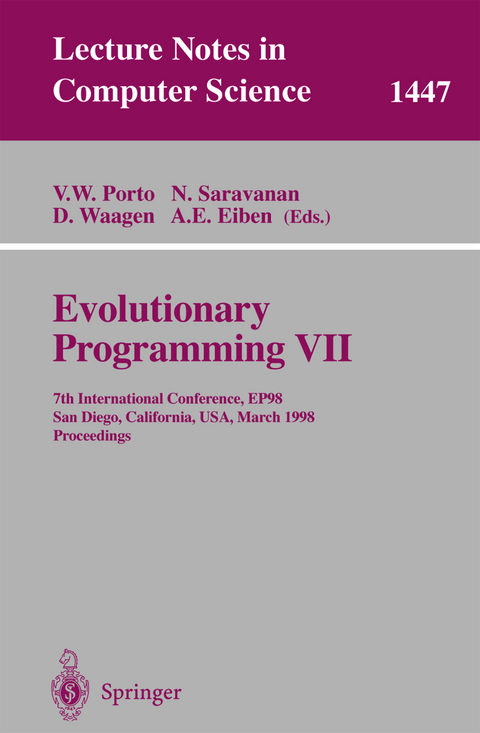
Evolutionary Programming VII
Springer Berlin (Verlag)
978-3-540-64891-8 (ISBN)
The volume presents 81 revised full papers selected from an overwhelming number of submissions. The papers are organized in topical sections on economics, emergence and complex systems; issues and innovations in evolutionary computation; applications; evolution-based approaches to engineering design; examining representations and operators; evolutionary computation theory; evolutionary computation and biological modeling; particle swarm; and combinations of evolutionary and neural computation.
The cumulative consensus of cognitive agents in scenarios: A framework for evolutionary processes in semantic memory.- Preferential partner selection in evolutionary labor markets: A study in agent-based computational economics.- Subspace pursuit for exploratory modeling.- Complete classes of strategies for the Classical Iterated Prisoner's Dilemma.- Evolutionary computing in multi-agent environments: Operators.- Evaluation of a simple host-parasite genetic algorithm.- Testing three paradigms for evolving groups of cooperative, simple agents.- Acquisition of general adaptive features by evolution.- Hybrid interior-lagrangian penalty based evolutionary optimization.- GA-Optimal fitness functions.- Scaling up evolutionary programming algorithms.- Short notes on the schema theorem and the building block hypothesis in genetic algorithms.- A superior evolutionary algorithm for 3-SAT.- Evolvable hardware control for dynamic reconfigurable and adaptive computing.- Evolutionary programming strategies with self-adaptation applied to the design of rotorcraft using parallel processing.- Optimization of thinned phased arrays using evolutionary programming.- Evolutionary domain covering of an inference system for function approximation.- Learning to re-engineer semantic networks using cultural algorithms.- Integration of slicing methods into a Cultural Algorithm in order to assist in large-scale engineering systems design.- Genetic search for object identification.- Fuzzy cultural algorithms with evolutionary programming.- Culturing evolution strategies to support the exploration of novel environments by an intelligent robotic agent.- Skeuomorphs and cultural algorithms.- Sphere operators and their applicability for constrained parameter optimization problems.- Numeric mutation as an improvement to symbolic regression in genetic programming.- Variable-dimensional optimization with evolutionary algorithms using fixed-length representations.- On making problems evolutionarily friendly part 1: Evolving the most convenient representations.- On making problems evolutionarily friendly part 2: Evolving the most convenient coordinate systems within which to pose (and solve) the given problem.- An experimental investigation of self-adaptation in evolutionary programming.- On the application of evolutionary pattern search algorithms.- The schema theorem and the misallocation of trials in the presence of stochastic effects.- On the "Explorative power" of ES/EP-like algorithms.- Resampling and its avoidance in genetic algorithms.- Evolutionary search for minimal elements in partially ordered finite sets.- Tailoring mutation to landscape properties.- A genetic programming methodology for missile countermeasures optimization under uncertainty.- Evolutionary algorithms for vertex cover.- An evolutionary self-learning methodology: Some preliminary results from a case study.- Evolving IIR filters in multipath environments.- Fuzzy partition and input selection by genetic algorithms for designing fuzzy rule-based classification systems.- Evolving nonlinear controllers for backing up a truck-and-trailer using evolutionary programming.- Reconstruction of DNA sequence information from a simulated DNA chip using evolutionary programming.- Using programmatic motifs and genetic programming to classify protein sequences as to cellular location.- Fully automated and rapid flexible docking of inhibitors covalently bound to serine proteases.- Microtubule networks as a medium for adaptive information processing.- Evolve IV: A metabolically-based artificial ecosystemmodel.- Sex, mate selection, and evolution.- Finding low energy conformations of atomic clusters using evolution strategies.- Estimating the distribution of neural connections in the saccadic system using a biologically plausible learning rule - Preliminary results.- Evolutionary algorithms combined with deterministic search.- Steady state memetic algorithm for partial shape matching.- A fully characterized test suite for genetic programming.- Genetic algorithms for belief network inference: The role of scaling and niching.- Building software frameworks for evolutionary computation.- Recorded step directional mutation for faster convergence.- The behavior of particles.- Parameter selection in particle swarm optimization.- Evolutionary optimization versus particle swarm optimization: Philosophy and performance differences.- Comparison between genetic algorithms and particle swarm optimization.- A hybrid evolutionary learning system for synthesizing neural network pattern recognition systems.- An evolutionary algorithm for designing feedforward neural networks.- Dual network representation applied to the evolution of neural controllers.- What does the landscape of a Hopfield associative memory look like?.- Visualization of evolutionary adaptation in R n.- On the application of cohort-driven operators to continuous optimization problems using evolutionary computation.- Random search versus genetic programming as engines for collective adaptation.- Optimal mutation and crossover rates for a genetic algorithm operating in a dynamic environment.- Local selection.- Asymmetric mutations for stochastic search.- Automated rule extraction for engine health monitoring.- Genetic programming for automatic target classification and recognition in synthetic aperture radar imagery.-Evolving heuristics for planning.- Solving cutting stock problems by evolutionary programming.- An empirical investigation of an evolutionary algorithm's ability to maintain a known good solution.- Evolving integrated low-level behaviors into intelligently interactive simulated forces.- Using offset invariant crossover as a tool for discovering cycle lengths of a periodic function.- Evolving a generalised behaviour: Artificial ant problem revisited.- Co-evolving functions in genetic programming: Dynamic ADF creation using GliB.- Evolving spatially-localized projection filters for SAR automatic target recognition.- Genetic programming in the overlapping generations model: An illustration with the dynamics of the inflation rate.
| Erscheint lt. Verlag | 5.8.1998 |
|---|---|
| Reihe/Serie | Lecture Notes in Computer Science |
| Zusatzinfo | XVI, 840 p. |
| Verlagsort | Berlin |
| Sprache | englisch |
| Maße | 170 x 244 mm |
| Gewicht | 1212 g |
| Themenwelt | Informatik ► Software Entwicklung ► User Interfaces (HCI) |
| Informatik ► Theorie / Studium ► Algorithmen | |
| Informatik ► Theorie / Studium ► Künstliche Intelligenz / Robotik | |
| Schlagworte | Algorithm analysis and problem complexity • algorithms • Complex Systems • Evolution • evolutionary computation • Evolutionary Programming • Evolution Strategies • Genetic algorithms • genetic programming • Genetische Algorithmen • Modeling • Programmierung • programming |
| ISBN-10 | 3-540-64891-7 / 3540648917 |
| ISBN-13 | 978-3-540-64891-8 / 9783540648918 |
| Zustand | Neuware |
| Haben Sie eine Frage zum Produkt? |
aus dem Bereich


